The amino-terminal domain of chloroplast Hsp93 is important for its membrane association and functions in vivo
- PMID: 22353577
- PMCID: PMC3320176
- DOI: 10.1104/pp.112.193300
The amino-terminal domain of chloroplast Hsp93 is important for its membrane association and functions in vivo
Abstract
Chloroplast 93-kD heat shock protein (Hsp93/ClpC), an Hsp100 family member, is suggested to have various functions in chloroplasts, including serving as the regulatory chaperone for the ClpP protease in the stroma and acting as a motor component of the protein translocon at the envelope. Indeed, although Hsp93 is a soluble stromal protein, a portion of it is associated with the inner envelope membrane. The mechanism and functional significance of this Hsp93 membrane association have not been determined. Here, we mapped the region important for Hsp93 membrane association by creating various deletion constructs and found that only the construct with the amino-terminal domain deleted, Hsp93-ΔN, had reduced membrane association. When transformed into Arabidopsis (Arabidopsis thaliana), most atHsp93V-ΔN proteins did not associate with membranes and atHsp93V-ΔΝ failed to complement the pale-green and protein import-defective phenotypes of an hsp93V knockout mutant. The residual atHsp93V-ΔN at the membranes had further reduced association with the central protein translocon component Tic110. However, the degradation of chloroplast glutamine synthetase, a potential substrate for the ClpP protease, was not affected in the hsp93V mutant or in the atHSP93V-ΔN transgenic plants. Hsp93-ΔN also had the same ATPase activity as that of full-length Hsp93. These data suggest that the association of Hsp93 with the inner envelope membrane through its amino-terminal domain is important for the functions of Hsp93 in vivo.
Figures
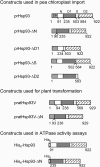
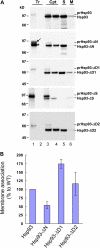
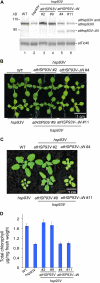

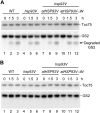


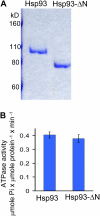
Similar articles
-
Quantitative analysis of the chloroplast molecular chaperone ClpC/Hsp93 in Arabidopsis reveals new insights into its localization, interaction with the Clp proteolytic core, and functional importance.J Biol Chem. 2014 Apr 18;289(16):11318-11330. doi: 10.1074/jbc.M113.534552. Epub 2014 Mar 5. J Biol Chem. 2014. PMID: 24599948 Free PMC article.
-
Functional Analysis of the Hsp93/ClpC Chaperone at the Chloroplast Envelope.Plant Physiol. 2016 Jan;170(1):147-62. doi: 10.1104/pp.15.01538. Epub 2015 Nov 19. Plant Physiol. 2016. PMID: 26586836 Free PMC article.
-
Stromal Hsp70 is important for protein translocation into pea and Arabidopsis chloroplasts.Plant Cell. 2010 May;22(5):1516-31. doi: 10.1105/tpc.109.071415. Epub 2010 May 18. Plant Cell. 2010. PMID: 20484004 Free PMC article.
-
Molecular chaperone involvement in chloroplast protein import.Biochim Biophys Acta. 2013 Feb;1833(2):332-40. doi: 10.1016/j.bbamcr.2012.03.019. Epub 2012 Apr 12. Biochim Biophys Acta. 2013. PMID: 22521451 Review.
-
Uvr motifs regulate the chloroplast Clp chaperone-protease system.Trends Plant Sci. 2025 Mar;30(3):269-282. doi: 10.1016/j.tplants.2024.09.015. Epub 2024 Oct 24. Trends Plant Sci. 2025. PMID: 39448301 Review.
Cited by
-
Chloroplast import motor subunits FtsHi1 and FtsHi2 are located on opposite sides of the inner envelope membrane.Proc Natl Acad Sci U S A. 2023 Sep 12;120(37):e2307747120. doi: 10.1073/pnas.2307747120. Epub 2023 Sep 5. Proc Natl Acad Sci U S A. 2023. PMID: 37669373 Free PMC article.
-
Chloroplast Hsp93 Directly Binds to Transit Peptides at an Early Stage of the Preprotein Import Process.Plant Physiol. 2016 Feb;170(2):857-66. doi: 10.1104/pp.15.01830. Epub 2015 Dec 16. Plant Physiol. 2016. PMID: 26676256 Free PMC article.
-
Quantitative analysis of the chloroplast molecular chaperone ClpC/Hsp93 in Arabidopsis reveals new insights into its localization, interaction with the Clp proteolytic core, and functional importance.J Biol Chem. 2014 Apr 18;289(16):11318-11330. doi: 10.1074/jbc.M113.534552. Epub 2014 Mar 5. J Biol Chem. 2014. PMID: 24599948 Free PMC article.
-
Non-native, N-terminal Hsp70 molecular motor recognition elements in transit peptides support plastid protein translocation.J Biol Chem. 2015 Mar 20;290(12):7602-21. doi: 10.1074/jbc.M114.633586. Epub 2015 Feb 2. J Biol Chem. 2015. PMID: 25645915 Free PMC article.
-
Polypeptide Transport-Associated Domains of the Toc75 Channel Protein Are Located in the Intermembrane Space of Chloroplasts.Plant Physiol. 2016 Sep;172(1):235-43. doi: 10.1104/pp.16.00919. Epub 2016 Jul 7. Plant Physiol. 2016. PMID: 27388682 Free PMC article.
References
-
- Chung MH, Chen MK, Pan SM. (2000) Floral spray transformation can efficiently generate Arabidopsis transgenic plants. Transgenic Res 9: 471–476 - PubMed
Publication types
MeSH terms
Substances
Associated data
- Actions
LinkOut - more resources
Full Text Sources
Molecular Biology Databases

